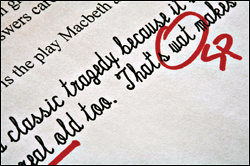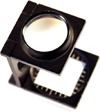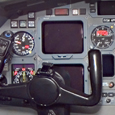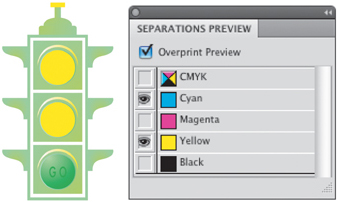Waiting until you have 20,000 finished copies of your project is a little late to find out the headline is misspelled. Or the text can’t be read at that point size. Or the color of the product is wrong.
The term “preflight” was coined by Chuck Weger back in 1990 at the Color Connections conference in San Francisco. The term came from the list of actions that airplane pilots take to ensure their plane is ready for flight and to make sure the plane doesn’t crash.
Chuck used it to signify that the file was ready for output and it wouldn’t crash the print processor. The term preflight soon became an industry standard used by many applications. (And no, Chuck doesn’t get royalties on it.)
A proof is a single-copy prototype of the finished product that helps you judge what your final piece will look like (or should look like). Different types of proofs are used for different stages of work.
It is important to build in the time and budget to properly preflight and proof your project at various stages.
I can’t spell. Honestly! I have a total brain block with words like “accomodate,” “embarrased,” and “knowlege.” I can’t remember how they are supposed to look. (Yes, I know they are misspelled here. I did it to prove my point. Did you catch those errors?)
That’s why it is really important that you do as much as you can to find errors before the job is finished.
If the application you are using has a spell check feature, use it. A spell check will look through your document and find those words it doesn’t recognize. But that doesn’t mean that a spell check will find all spelling mistakes. Consider the following:
Their is knot any thing wrung with this cent tents.
It is utter nonsense. But no spell checker would ever catch it as being misspelled because those are actual words. A spell checker can only find words that it doesn’t recognize. But real words in the wrong position won’t show up.
This is why it is vital that you add time to send your job to a proofreader to make sure you haven’t used the wrung words.

A misspelled word is embarrassing. The wrong price could cost you or your client lots of money in angry customers. If you have any pricing information in your project, you must have at least two different people check those prices before the job goes out to be printed.
There are ways to automate the proofing process. For instance, I have some automation controls in my page layout program that will look through my documents to make sure I haven’t put two spaces between a word.
But you can’t totally rely on automation. You must build time into a project to have it properly proofread. Find a proofreader. These are very smart people who know where the commas are supposed to be. They also have incredibly sharp eyes and can see where a wide em space has been inserted instead of the shorter en space.
OK, so once you know the words and text are correct, you still have production errors to look for. Perhaps you’re working on a spot color job. You wouldn’t want any process colors to sneak in. Or you want to make sure that all your images are at the right resolution and color mode.
With a single-page ad, it’s pretty simple to check all the elements on the page. But consider a long document with hundreds of elements and images. You really don’t want to check all those items individually.

I once explained to a student that it would be impossible for anyone to read 4-point white text set on a the black area of a color photo. She replied, “Then why did the software let me do it?”
Most page layout software has some sort of preflight controls that check various elements in the document. But not all preflight controls will check for things like text that is too small to be read. The software can’t stop you from doing something it doesn’t know how to identify.
In the past, Preflight has usually been applied just before a file goes out the door to the print provider. You would run the preflight command and then get a list of any missing fonts, wrong color images, or other problems.
However, one nice feature in InDesign is its Live Preflight feature. Instead of waiting till you’re finished working, the Live Preflight continually checks your document for any errors and displays a green mark if everything is OK, and a red mark if it finds problems.
QuarkXPress uses a slightly different approach. It allows you to set a preference to evaluate a file when you open it, save it, output (print) it, or close it.

You may use software that doesn’t have any preflight controls. For instance, Adobe Illustrator has no built-in preflight at all. If that is the case, you should consider investing in a separate preflight program such as Markzware’s FlightCheck Designer (markzware.com). This application looks at all sorts of documents including PDF files.
Your monitor is actually your first proofing device. The image on the monitor is sometimes called a soft proof because it is the software that controls the appearance of the file.
You can easily judge if all your elements are in position, but you should not rely on your monitor as your only proofing device. You can’t judge colors correctly; you can’t tell if the colors will output onto the appropriate separate plates; and you can’t tell if fonts and vector images will output correctly.
Ordinarily you can just use a desktop printing machine to output text for proofreading. You can also create simple PDF files and have your clients review the text on screen.
But it might be important to know if the point size of text is too small to be read easily. A desktop printing machine won’t help you there. Its output resolution is too low to accurately judge fine details in text. If it’s important to know exactly what text and vector illustrations will look like, you may want to send the files to a print provider for high-resolution RC paper proofs. You wouldn’t want to send an entire book out, but you can send a few sample pages out for tests. This will give you the best idea of whether or not your lines are thick enough to be printed with ink on a press.
Before you send your file out, it is important to know how the colors are going to separate and if you have too many spot colors. In the old days, I used to print out paper separations from my laser printer and check the colors on the pages.
Today it is much easier to use the built-in separations preview in programs such as Acrobat Professional, Adobe Illustrator, and Adobe InDesign. With just a click, I can turn on and off the process and spot colors in a document. This is a great way to see if you’ve defined your colors correctly.

An example of how you can preview the process color separations on screen. Here, the cyan and yellow plates are displayed together while the magenta and black plates are hidden.
Digital color proofs are output by color printers such as inkjet, dye-sub, thermal wax, and laser. As mentioned in Chapter 2, the color quality of these proofs varies depending on the type of printer. If you have a very tight color management system in place, you can use these as a preliminary color proof to show the client. But it is never going to be press quality.
Digital proofs are quick and economical. It’s easy to go back to the electronic file to make corrections. However, because they are not made from film separations (like laminate proofs; covered later in this chapter), they cannot flag certain problems such as moiré patterns or incorrect overprints. They also can’t give you information on spot colors. Nonetheless, they are excellent if you only have a monitor and a black-and-white desktop printer to judge your work.
Some print shops use digital color proofs as contract proofs, which is a proof of the job used by the print shop to show what the final product must look like. If your job is an expensive four-color process piece or if you need to see precise color, you don’t want to use (nor will the print shop agree to use) this kind of proof for matching the color of the finished job.
A print shop or service bureau makes overlay proofs (sometimes called color keys) by taking the color separations and exposing different pieces of film for each color of the project. The pieces of film are colored with the CMYK colors, limited spot colors, or a combination of both. These pieces of film are then placed over each other to form a composite of the final image.
Unfortunately, the film used in overlay proofs has a slight yellow color, so when the layers of film are stacked on top of each other they tend to change the color of the image. Overlay proofs should not be used for proofing when color correction is important. However, they are excellent for flagging moiré patterns (see Chapter 9) and other problems with separations.
If you’ve never seen an overlay proof, ask your print shop if they have an old one you can look at. It’s the best lesson on the CMYK process you’ll ever have. You can lift up each layer of film to see those dots of cyan, magenta, yellow, and black that I’m always talking about in this book, and see how the combination of the dots creates all the various colors.
A print shop makes blueline proofs by taking film separations and combining them together into one photographic print. This creates a single page that shows all of the elements in position.
Blueline proofs are quicker and easier to make than overlay proofs and usually cost less. Use a blueline to make sure all the elements are in position, but not to check problems with dot screens or moiré patterns. The benefit of blueline proofs as opposed to a laser print is that the blueline proof is created using the same print processor as the final output. That way if there is a problem with an image or color not printing correctly, you’ll see it. A laser proof might not display the problem.
For a project like this book, the print provider makes bluelines of all the signatures for the book (see Chapter 2). They fold, sew-bind, and trim them, and send my publisher a complete copy of the book to proof. It looks like the real book, except it’s blue (yes, blue-ish paper and blue ink, like a contractor’s blueprint) and each signature is separately bound. The production manager and my editor can proof for positioning, typos, page count, and other various features.
A print shop or service bureau makes laminate proofs from the film separations by taking layers of CMYK toners or spot color material and applying them onto a special base. The layers of color are then laminated together. In the days before digital production, this was the first chance a customer had to see what the job looked like with all the elements in position and in color.
A laminate proof is the closest thing to the finished job, and it represents the most faithful color because the color is produced from the same separations that will make the final printing plates. Unlike overlay proofs, there are no film layers that affect the color of the pages.
Laminate proofs are expensive and take time. Your print shop will tell you if that time and money is worth it. Typically they are used only to proof expensive, full-color jobs. For instance, my publisher might ask for a laminate proof of the cover of this book, but would never ask for a laminate proof of the interior pages.
Some print shops use laminate proofs as contract proofs to show what the final print run must look like; if the job doesn’t turn out like the contract proof, the customer can ask for the job to be reprinted (but if the project is that important, the client should be at the press check; see next section). If the project is to be reproduced in full color, many print shops require a laminate proof of every page, even for an entire book, before they will print the job.
Different print shops use different systems to create their laminate proofs, such as Chromalin, Matchprint, or Agfaproof. The Matchprint brand is so popular that many people refer to a laminate proof as a matchprint, regardless of what brand the print shop uses.
Press proofs are printed samples that are created using the actual plates for the job running on the printing press. The actual paper and ink for the final job are also used. Press proofs are very expensive because they have to set up the entire press as if they were going to print the entire project. You do not need a press proof unless you use a print shop located in another country, in which case you would want to see exactly what the job is going to look like before the entire run is printed.

Big ad agencies, design studios, and publishing houses often send a production person and sometimes the designer to the print shop for a press check to make sure the printed pieces are exactly what they want. Typically you would only spend the time on a press check in a four-color job, and in that case the job is usually printed on a four-color press, with four giant rollers, so what comes off at the end is a finished four-color piece. It’s amazing.
In a press check, the job is set up on the press and ready to roll. It does roll. As the signatures come off the press, the production person and/or designer look over the pages under a color-corrected light. If the color is not quite right, the press operator can actually push some buttons on a control panel and adjust the ink flow to suit the designer and to match the laminate proof. Maybe it needs more red in the sunset, or less blue in the face—the press operator adjusts it. When everyone is happy with the color, the registration, and all the details, the designer signs a perfect page indicating approval, and the rest of the print run is monitored to match the approved page.
In the direct-to-plate process mentioned in Chapter 3, the print provider skips the process of creating film separations. This means they can’t make bluelines, color overlays, or laminate proofs, but they can make electronic prepress digital proofs that are different from conventional bluelines, but perform the same function.
If you need to see color, make a digital color proof before going direct-to-plate, or have the print shop make an electronic prepress digital color proof. You can’t expect the color in the digital proofs to be as close to the final product as in laminate proofs, but at least you will have a good idea of what to expect.
Once you’ve created film or plates, what happens if you discover an error? What if you find an incorrect phone number, a misspelled client’s name, or maybe you’ve changed the price? Is there anything you can do? Yes, print providers have always been able to make minor changes to film or plates.
If you discover a mistake after the film or plates have been made, talk to the print shop. Depending on what the mistake is and where it is located on the page, the print shop may still be able to make a correction. If they can’t make it, you might have to go back to your electronic file, make the correction, and provide the print shop with new output. Do expect to pay for the service.
What if you’ve printed the entire job and then discover a mistake? It’s completely impossible to change it then, right? Well actually not. It just depends on how important the mistake is. If you had 5,000 copies of a book completely printed, bound, and trimmed, and then discover you forgot to put a line of copy on the cover, you can go back to the print shop and have stickers printed up. Then someone manually puts the stickers on all of the covers. It’s expensive, but it’s possible and it’s less expensive than reprinting the entire book. Now, how do you think I know this? Do you think it might have happened to one of my book?
You’ve surely read publications before that included a small “errata” slip explaining the errors that were discovered after printing. If you have great marketing skills, you can convince the world that the version of your job that includes the mistakes is a collector’s item woth thousands of dollars.
And I am positive that somewhere in this book there is a typo that you will catch. However, you never know, with me, what is the the typo and what is the intentional error.

